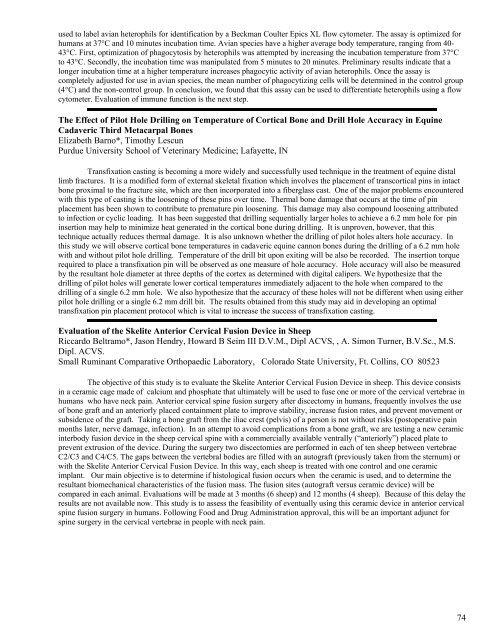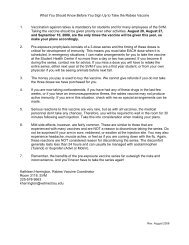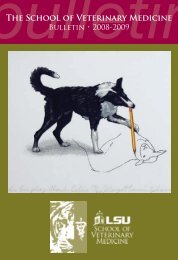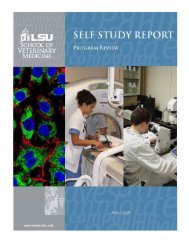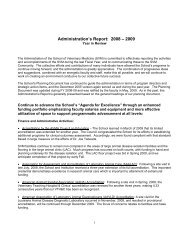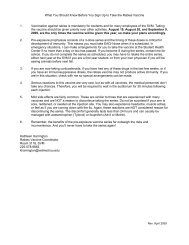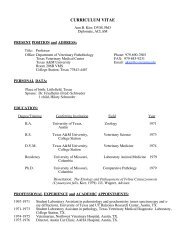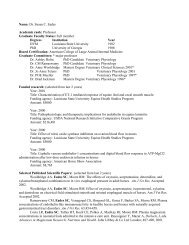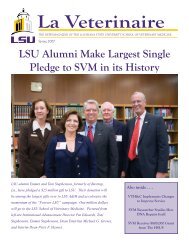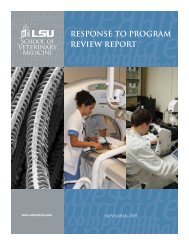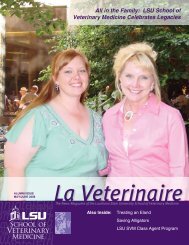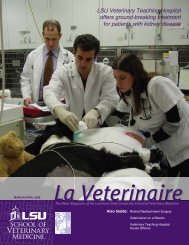used to label avian heterophils for identification by a Beckman Coulter Epics XL flow cytometer. The assay is optimized forhumans at 37°C and 10 minutes incubation time. Avian species have a higher average body temperature, ranging from 40-43°C. First, optimization <strong>of</strong> phagocytosis by heterophils was attempted by increasing the incubation temperature from 37°Cto 43°C. Secondly, the incubation time was manipulated from 5 minutes to 20 minutes. Preliminary results indicate that alonger incubation time at a higher temperature increases phagocytic activity <strong>of</strong> avian heterophils. Once the assay iscompletely adjusted for use in avian species, the mean number <strong>of</strong> phagocytizing cells will be determined in the control group(4°C) and the non-control group. In conclusion, we found that this assay can be used to differentiate heterophils using a flowcytometer. Evaluation <strong>of</strong> immune function is the next step.The Effect <strong>of</strong> Pilot Hole Drilling on Temperature <strong>of</strong> Cortical Bone and Drill Hole Accuracy in EquineCadaveric Third Metacarpal BonesElizabeth Barno*, Timothy LescunPurdue University <strong>School</strong> <strong>of</strong> <strong>Veterinary</strong> <strong>Medicine</strong>; Lafayette, INTransfixation casting is becoming a more widely and successfully used technique in the treatment <strong>of</strong> equine distallimb fractures. It is a modified form <strong>of</strong> external skeletal fixation which involves the placement <strong>of</strong> transcortical pins in intactbone proximal to the fracture site, which are then incorporated into a fiberglass cast. One <strong>of</strong> the major problems encounteredwith this type <strong>of</strong> casting is the loosening <strong>of</strong> these pins over time. Thermal bone damage that occurs at the time <strong>of</strong> pinplacement has been shown to contribute to premature pin loosening. This damage may also compound loosening attributedto infection or cyclic loading. It has been suggested that drilling sequentially larger holes to achieve a 6.2 mm hole for pininsertion may help to minimize heat generated in the cortical bone during drilling. It is unproven, however, that thistechnique actually reduces thermal damage. It is also unknown whether the drilling <strong>of</strong> pilot holes alters hole accuracy. Inthis study we will observe cortical bone temperatures in cadaveric equine cannon bones during the drilling <strong>of</strong> a 6.2 mm holewith and without pilot hole drilling. Temperature <strong>of</strong> the drill bit upon exiting will be also be recorded. The insertion torquerequired to place a transfixation pin will be observed as one measure <strong>of</strong> hole accuracy. Hole accuracy will also be measuredby the resultant hole diameter at three depths <strong>of</strong> the cortex as determined with digital calipers. We hypothesize that thedrilling <strong>of</strong> pilot holes will generate lower cortical temperatures immediately adjacent to the hole when compared to thedrilling <strong>of</strong> a single 6.2 mm hole. We also hypothesize that the accuracy <strong>of</strong> these holes will not be different when using eitherpilot hole drilling or a single 6.2 mm drill bit. The results obtained from this study may aid in developing an optimaltransfixation pin placement protocol which is vital to increase the success <strong>of</strong> transfixation casting.Evaluation <strong>of</strong> the Skelite Anterior Cervical Fusion Device in SheepRiccardo Beltramo*, Jason Hendry, Howard B Seim III D.V.M., Dipl ACVS, , A. Simon Turner, B.V.Sc., M.S.Dipl. ACVS.Small Ruminant Comparative Orthopaedic Laboratory, Colorado <strong>State</strong> University, Ft. Collins, CO 80523The objective <strong>of</strong> this study is to evaluate the Skelite Anterior Cervical Fusion Device in sheep. This device consistsin a ceramic cage made <strong>of</strong> calcium and phosphate that ultimately will be used to fuse one or more <strong>of</strong> the cervical vertebrae inhumans who have neck pain. Anterior cervical spine fusion surgery after discectomy in humans, frequently involves the use<strong>of</strong> bone graft and an anteriorly placed containment plate to improve stability, increase fusion rates, and prevent movement orsubsidence <strong>of</strong> the graft. Taking a bone graft from the iliac crest (pelvis) <strong>of</strong> a person is not without risks (postoperative painmonths later, nerve damage, infection). In an attempt to avoid complications from a bone graft, we are testing a new ceramicinterbody fusion device in the sheep cervical spine with a commercially available ventrally (“anteriorly”) placed plate toprevent extrusion <strong>of</strong> the device. During the surgery two discectomies are performed in each <strong>of</strong> ten sheep between vertebraeC2/C3 and C4/C5. The gaps between the vertebral bodies are filled with an autograft (previously taken from the sternum) orwith the Skelite Anterior Cervical Fusion Device. In this way, each sheep is treated with one control and one ceramicimplant. Our main objective is to determine if histological fusion occurs when the ceramic is used, and to determine theresultant biomechanical characteristics <strong>of</strong> the fusion mass. The fusion sites (autograft versus ceramic device) will becompared in each animal. Evaluations will be made at 3 months (6 sheep) and 12 months (4 sheep). Because <strong>of</strong> this delay theresults are not available now. This study is to assess the feasibility <strong>of</strong> eventually using this ceramic device in anterior cervicalspine fusion surgery in humans. Following Food and Drug Administration approval, this will be an important adjunct forspine surgery in the cervical vertebrae in people with neck pain.74
A study to evaluate plasma substance P, cortisol response and salicylate concentration in bulls followingcastration with or without non-steroidal anti-inflammatory drug analgesiaAngela Bettenhausen*, Johann CoetzeeDepartment <strong>of</strong> Clinical Sciences, College <strong>of</strong> <strong>Veterinary</strong> <strong>Medicine</strong>, Kansas <strong>State</strong> University. Manhattan, KS.Pain and distress inflicted by normal husbandry procedures such as castration are major animal welfare concerns inbeef cattle production. Acute cortisol response has been used to determine the extent and duration <strong>of</strong> distress associated withcastration in cattle. However, plasma cortisol measurement also measures homeostasis and cannot reliably discriminatebetween a painful and a stressful response. The need for a robust, repeatable physiological indicator <strong>of</strong> distress for use in theassessment <strong>of</strong> production procedures and environments has been recognized. A strong candidate is substance P and wehypothesize that the measurement <strong>of</strong> the plasma concentrations <strong>of</strong> this substance may be a robust, repeatable physiologicalindicator <strong>of</strong> pain and distress in cattle following castration. A study was conducted to evaluate the relationship betweenplasma substance P concentrations and cortisol response in association with plasma salicylate concentrations in twenty bullsthat were surgically castrated. The impact <strong>of</strong> administration <strong>of</strong> aspirin and sodium salicylate on animal well-being isincluded in this study as an alternative management technique to be considered by producers to alleviate pain at the time <strong>of</strong>castration. A group <strong>of</strong> five bulls served as intact controls, five bulls served as castrated controls, five bulls received oralaspirin at the dose <strong>of</strong> 50 mg/kg BW prior to castration and five bulls received an injection <strong>of</strong> sodium salicylate at the dose <strong>of</strong>50 mg/kg BW prior to castration. Blood samples for substance P, cortisol, and salicylate determination were collected priorto castration, immediately following castration and at 10, 20, 30, 40, 50 and 60 minutes and at 1.5, 2, 4, 6, 8, 10 and 12 hoursthereafter. Plasma substance P was determined by competitive immunoassay, cortisol by chemiluminescent enzymeimmunoassay, and plasma salicylate was determined by commercial immunoassay.Real-time monitoring <strong>of</strong> Salmonella poultry isolates on chicken skinT.D. Bodet*, M.L. Lawrence, A. Karsi, R.H. BaileyCollege <strong>of</strong> <strong>Veterinary</strong> <strong>Medicine</strong>, Mississippi <strong>State</strong> University, Mississippi <strong>State</strong>, MSSalmonella, a member <strong>of</strong> the family Enterobacteriaceae, is a gram-negative bacteria that causes enteric disease inmultiple animal species. Infection occurs as a result <strong>of</strong> ingestion <strong>of</strong> the bacteria, and salmonellosis may or may not occurdepending on the amount <strong>of</strong> bacteria ingested and host susceptibility. Human infection is highly associated with poultry byconsumption <strong>of</strong> undercooked meat or eggs or by consumption <strong>of</strong> cross contaminated food. Therefore, it is important tounderstand and further investigate the locations and quantities <strong>of</strong> Salmonella within the bird and possible interventions thatcould be used to reduce the risk <strong>of</strong> human infection. Ten Salmonella serovars have been identified as posing the greatest riskto humans from poultry products: Typhimurium, Kentucky, Montevideo, Mbandaka, Thompson, Schwarzengrund, Alachua,Seftenberg, Braenderup, and Heidelberg. pAKlux1 is a plasmid expressing bacterial luciferase that allows real-time detectionand quantification <strong>of</strong> Salmonella using luminescence. This plasmid was successfully transferred by electroporation intopoultry isolates from nine <strong>of</strong> the ten serovars (electroporation attempts into serovar Braenderup were unsuccessful), and itwas transferred into a non-pathogenic strain from serovar Typhimurium. The minimum number <strong>of</strong> detectable bioluminescentSalmonella was estimated using an IVIS imaging system. Plasmid stability was considered in a 15 day experiment measuringthe bacteria’s luminescence in broth with and without antibiotic. A model was also developed to monitor the amount <strong>of</strong>Salmonella on chicken skin. The process <strong>of</strong> rinsing the bird in the chicken plant was mimicked by submerging the skin inagitated cold water to test for the removal <strong>of</strong> Salmonella.A comparison <strong>of</strong> limb speed and trunk speed in dogs <strong>of</strong> varying sizeBottorff, B.S., Kim, J., Breur, G.J.Purdue University <strong>School</strong> <strong>of</strong> <strong>Veterinary</strong> <strong>Medicine</strong>Gait analysis is an <strong>of</strong>ten underutilized diagnostic tool that may be used to identify features <strong>of</strong> specific gaitabnormalities and make gait comparisons regarding different populations. Most commonly it is used as a non-invasive,objective, and quantitative method to evaluate orthopedic injury or measure functional return after treatment. Most researchon gait has been conducted on large breed dogs. Before gait analysis can be widely used for clinical patients, the techniquesused in larger dogs may have to be validated in smaller dogs. For instance, in large dogs, subject’s trunk velocity ismeasured, assuming it is an accurate representation <strong>of</strong> limb velocity. While in certain instances this assumption may be true,in others it may not be completely accurate. As a result, other measurements <strong>of</strong> gait may be miscalculated as variations inlimb velocity have been shown to affect vertical impulse and ground reaction force data, along with other variables.The objective <strong>of</strong> this study is to describe the discrepancy between limb velocity and trunk velocity during gait in small andlarge breed dogs. Five dogs in each <strong>of</strong> two size classifications (small, not exceeding 20 lbs; and large, over 55 lbs.) will becompared using kinetic and kinematic methods to analyze limb and trunk velocity. Measurements for trunk velocity will beobtained via analysis <strong>of</strong> time required for subject’s trunk to interrupt 9 photocells placed at 0.5 m interval, as well asdisplacement <strong>of</strong> a marker on the center <strong>of</strong> mass with 2-dimensional video analysis. Limb velocity measurements will be75
- Page 1 and 2:
2006 MERCK/MERIALNATIONAL VETERINAR
- Page 6 and 7:
3:00-3:30 pm BreakNovel therapy for
- Page 8 and 9:
KEYNOTE SPEAKERRonald Veazey, D.V.M
- Page 10 and 11:
Mini Symposium II:Fish Research: A
- Page 12 and 13:
David G. Baker, D.V.M., M.S., Ph.D.
- Page 14 and 15:
Konstantin G. Kousoulas, Ph.D.Profe
- Page 16 and 17:
Joseph Francis, B.V.Sc., M.V.Sc., P
- Page 18 and 19:
dogs with cancer, the potential rol
- Page 20 and 21:
2006 MERCK/MERIALVETERINARY SCHOLAR
- Page 22 and 23:
YOUNG INVESTIGATOR AWARD HONORABLE
- Page 24 and 25: Mammary epithelial-specific deletio
- Page 26 and 27: 2006 MERCK/MERIALVETERINARY SCHOLAR
- Page 28: Variation in Q-Tract Length of the
- Page 34: Novel therapy for humoral hypercalc
- Page 38: ALTERNATE:Micron-scale membrane sub
- Page 42 and 43: ABSTRACT TITLES LISTED BY CATEGORY
- Page 44 and 45: 19. A pilot study of cigarette smok
- Page 46 and 47: 36. Development of a murine in vitr
- Page 48 and 49: ABSTRACT TITLES LISTED BY CATEGORY
- Page 50 and 51: 71. Identification and characteriza
- Page 52 and 53: 85. Age and Gender Influence Ventil
- Page 54 and 55: ABSTRACT TITLES LISTED BY CATEGORY
- Page 56 and 57: 2006 MERCK/MERIALVETERINARY SCHOLAR
- Page 58 and 59: 10. Preliminary estimation of risk
- Page 60 and 61: ABSTRACT TITLES LISTED BY CATEGORY
- Page 62 and 63: 47. Osteoprotegerin and Receptor Ac
- Page 64 and 65: 61. A Comparison of Interaction Pat
- Page 66 and 67: ABSTRACT TITLES LISTED BY CATEGORY
- Page 68 and 69: ABSTRACT TITLES LISTED BY CATEGORY
- Page 70 and 71: ABSTRACT TITLES LISTED BY CATEGORY
- Page 72 and 73: 2006 MERCK/MERIALVETERINARY SCHOLAR
- Page 76 and 77: obtained via analysis of time and d
- Page 78 and 79: 0.71mg/dL; p=0.001). Values for hem
- Page 80 and 81: mass and fecundity in prespawning w
- Page 82 and 83: Equine Hoof Laminae Tissue Collecti
- Page 84 and 85: Aspiration Pneumonia in DogsDavid A
- Page 86 and 87: Distortion Product Otoacoustic Emis
- Page 88 and 89: tyrosine phosphorylation is measure
- Page 90 and 91: the gravid and non-gravid females t
- Page 92 and 93: egulatory function as its ortholog,
- Page 94 and 95: PATHOLOGY, TOXICOLOGY, AND ONCOLOGY
- Page 96 and 97: Markers of Oxidative Stress in plas
- Page 98 and 99: has been isolated from all samples
- Page 100 and 101: Matrix metalloproteinase secretion
- Page 102 and 103: Reproductive performance, neonatal
- Page 104 and 105: control to determine the efficiency
- Page 106 and 107: Enhancing the Quality and Reliabili
- Page 108 and 109: grade II MCTs into groups with good
- Page 110 and 111: Transcriptional Regulation of the I
- Page 112 and 113: MICROBIOLOGY AND IMMUNOLOGY (SESSIO
- Page 114 and 115: colonization of the mutant and 6 re
- Page 116 and 117: digestive tracts of these and other
- Page 118 and 119: 100 pfu BRSV. The results show that
- Page 120 and 121: Inhibition of Microneme Secretion i
- Page 122 and 123: Adherent bacilli were present in th
- Page 124 and 125:
isolated to analyze cytokine gene e
- Page 126 and 127:
purified, viral RNA was extracted a
- Page 128 and 129:
The effects of co-engagement of TLR
- Page 130 and 131:
Occurrence of Leptospira Vaccine Fa
- Page 132 and 133:
undifferentiated catecholaminergic
- Page 134 and 135:
the concept that the greater detoxi
- Page 136 and 137:
quantitative PCR using gene targets
- Page 138 and 139:
Rotenone Induced Dopamine Neuron De
- Page 140 and 141:
decrease in serum cortisol, with a
- Page 142 and 143:
and detrimental impacts on the brai
- Page 144 and 145:
actions of cells prior to embryo de
- Page 146 and 147:
Utilizing cDNA Subtraction to Exami
- Page 148 and 149:
expression in unilaterally pregnant
- Page 150 and 151:
Salmonella is increased. Poultry sa
- Page 152 and 153:
exports. The estimated prevalence o
- Page 154 and 155:
eeding grounds near Minnedosa, MB s
- Page 156 and 157:
(PBMC) were isolated using commerci
- Page 158 and 159:
2006 MERCK/MERIALVETERINARY SCHOLAR
- Page 160 and 161:
Trainees acquire in-depth knowledge
- Page 162 and 163:
comparative pathology and/or resear
- Page 164 and 165:
Department of Veterinary Bioscience
- Page 166 and 167:
PhD, Director, Center for Comparati
- Page 168 and 169:
2006 MERCK/MERIALVETERINARY SCHOLAR
- Page 170 and 171:
MICHIGAN STATEUNIVERSITYJames Crawf
- Page 172:
UNIVERSITY OFPENNSYLVANIALindsay Th


